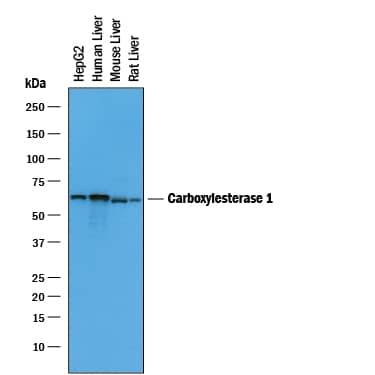Human/Mouse/Rat Carboxylesterase 1/CES1 Antibody
R&D Systems, part of Bio-Techne | Catalog # AF4920


Key Product Details
Species Reactivity
Validated:
Cited:
Applications
Validated:
Cited:
Label
Antibody Source
Product Specifications
Immunogen
His19-Glu563
Accession # NP_001020365
Specificity
Clonality
Host
Isotype
Scientific Data Images for Human/Mouse/Rat Carboxylesterase 1/CES1 Antibody
Detection of Human, Mouse, and Rat Carboxylesterase 1/CES1 by Western Blot.
Western blot shows lysates of HepG2 human hepatocellular carcinoma cell line, human liver tissue, mouse liver tissue, and rat liver tissue. PVDF membrane was probed with 0.2 µg/mL of Goat Anti-Human/Mouse/Rat Carboxylesterase 1/CES1 Antigen Affinity-purified Polyclonal Antibody (Catalog # AF4920) followed by HRP-conjugated Anti-Goat IgG Secondary Antibody (Catalog # HAF019). A specific band was detected for Carboxylesterase 1/CES1 at approximately 63 kDa (as indicated). This experiment was conducted under reducing conditions and using Immunoblot Buffer Group 1.Detection of Human and Mouse Carboxylesterase 1/CES1 by Simple WesternTM.
Simple Western lane view shows lysates of human liver tissue and mouse liver tissue, loaded at 0.2 mg/mL. A specific band was detected for Carboxylesterase 1/CES1 at approximately 62 kDa (as indicated) using 2 µg/mL of Goat Anti-Human/Mouse/Rat Carboxylesterase 1/CES1 Antigen Affinity-purified Polyclonal Antibody (Catalog # AF4920) followed by 1:50 dilution of HRP-conjugated Anti-Goat IgG Secondary Antibody (Catalog # HAF109). This experiment was conducted under reducing conditions and using the 12-230 kDa separation system.Applications for Human/Mouse/Rat Carboxylesterase 1/CES1 Antibody
Simple Western
Sample: Human liver tissue and mouse liver tissue
Western Blot
Sample: HepG2 human hepatocellular carcinoma cell line, human liver tissue, mouse liver tissue, and rat liver tissue
Reviewed Applications
Read 1 review rated 5 using AF4920 in the following applications:
Formulation, Preparation, and Storage
Purification
Reconstitution
Formulation
Shipping
Stability & Storage
- 12 months from date of receipt, -20 to -70 °C as supplied.
- 1 month, 2 to 8 °C under sterile conditions after reconstitution.
- 6 months, -20 to -70 °C under sterile conditions after reconstitution.
Background: Carboxylesterase 1/CES1
Carboxylesterase 1 (CES1) is a member of a large family of carboxylesterases that are responsible for the hydrolysis of ester and amide bonds (1, 2). They have broad substrate specificity ranging from small molecule esters such as phenylester to long chain fatty acid esters and thioesters. They play a major role as determinants of pharmacokinetic behavior for most therapeutic agents containing an ester. By de-esterification, they can activate or inactivate the agents. They also participate in detoxification of drugs such as cocaine and heroin in serum and liver. The resulting de-esterified metabolites are secreted out in urine. They can also detoxify organophosphate and carbamate analogues used in agrochemicals or chemical nerve agents, such as malathion, sarin, tabun, and VX. In addition to the hydrolytic activity, they can perform transesterification, a reaction important for cholesterol homeostasis. Carboxylesterase deficiency may be associated with non-Hodgkin lymphoma or B-cell lymphocytic leukemia. CES1 shares the serine hydrolase fold observed in other esterases (3). CES1 possesses an endoplasmic reticulum retention signal (HIEL) at its C-terminus.
References
- Redinbo, M.R. and P.M. Potter (2005) Drug Discovery Today 10:313.
- Satoh, T. and M. Hosokawa (2006) Chem. Biol. Interactions 162:195.
- Fleming, C.D. et al. (2007) Biochemistry 46:5603.
Alternate Names
Gene Symbol
UniProt
Additional Carboxylesterase 1/CES1 Products
Product Documents for Human/Mouse/Rat Carboxylesterase 1/CES1 Antibody
Product Specific Notices for Human/Mouse/Rat Carboxylesterase 1/CES1 Antibody
For research use only
